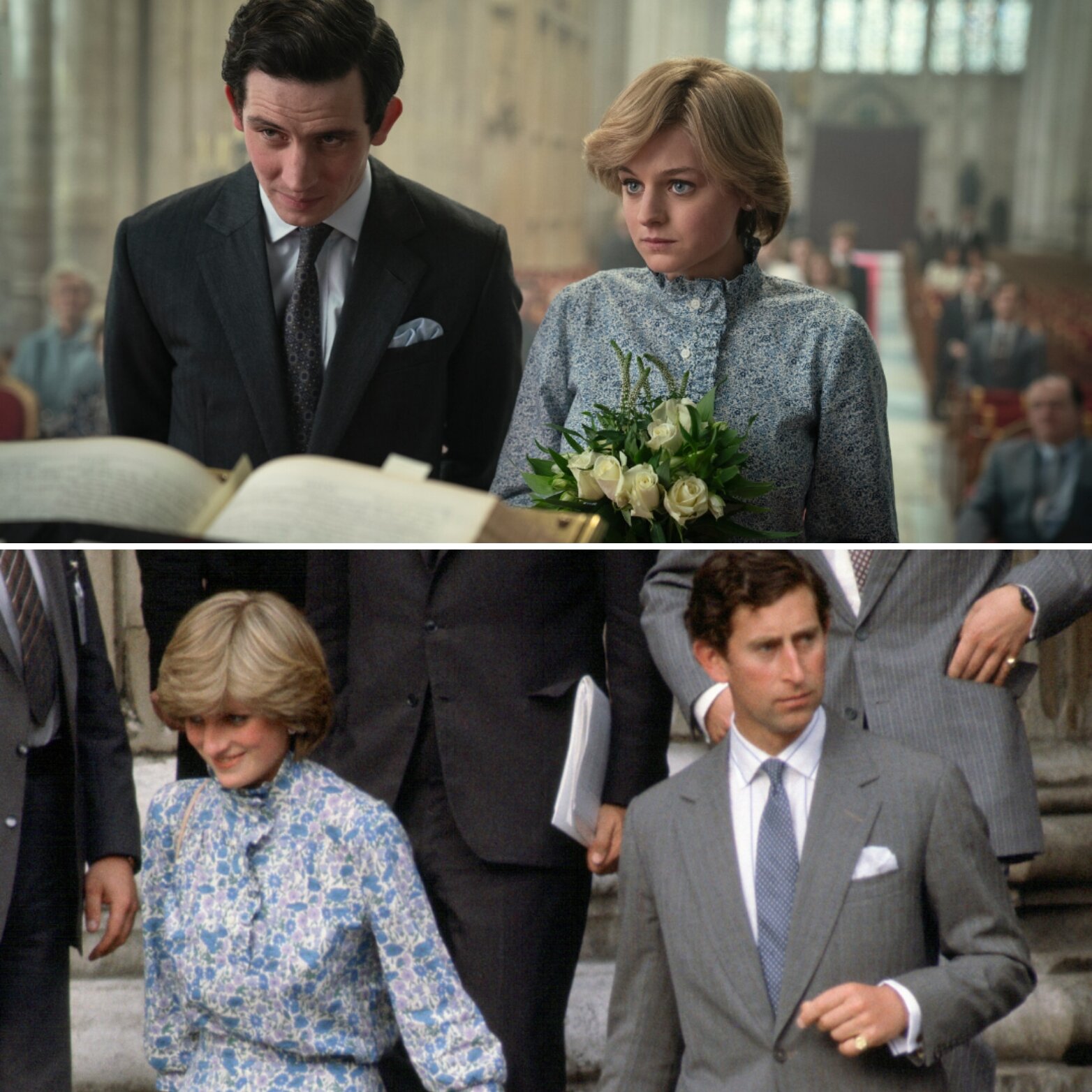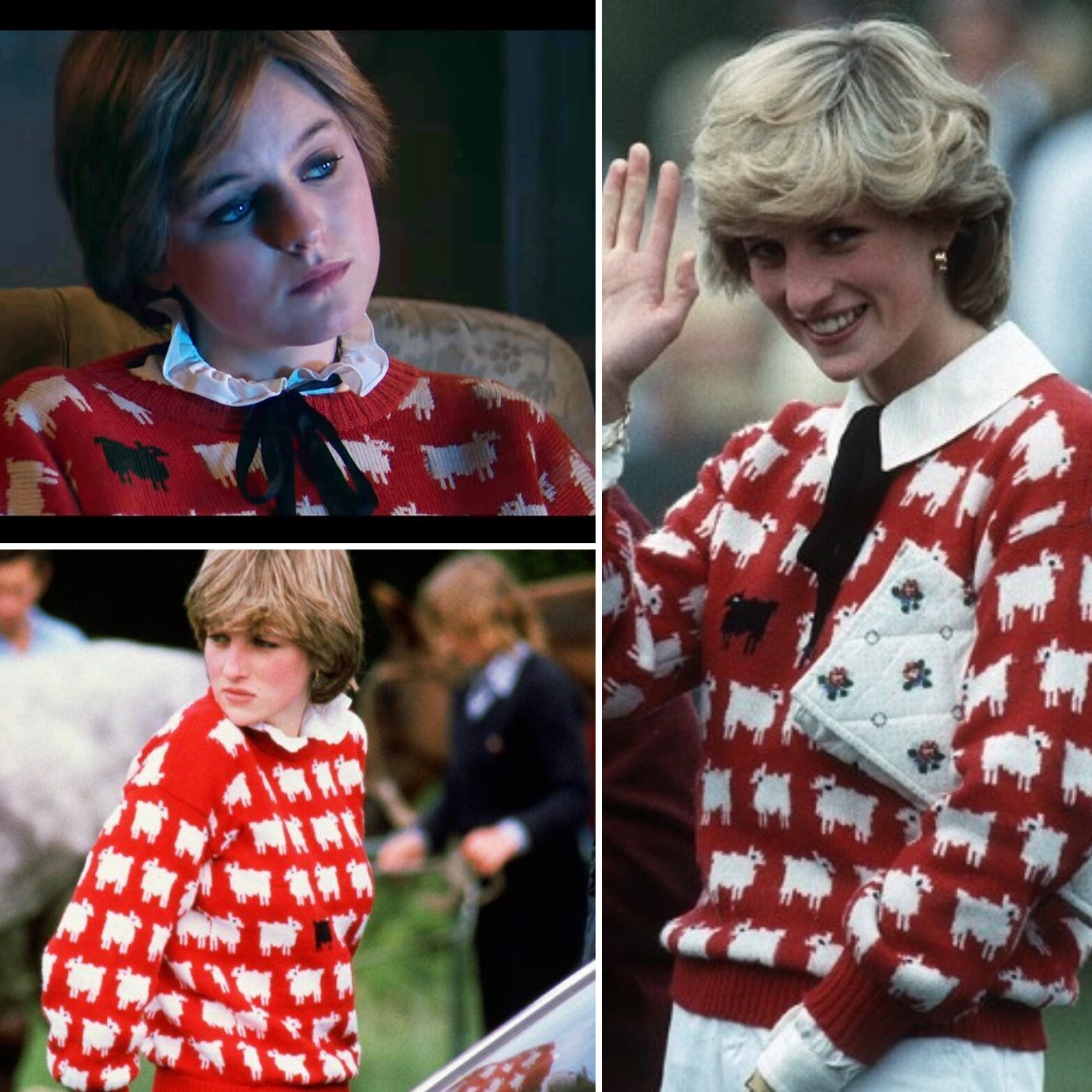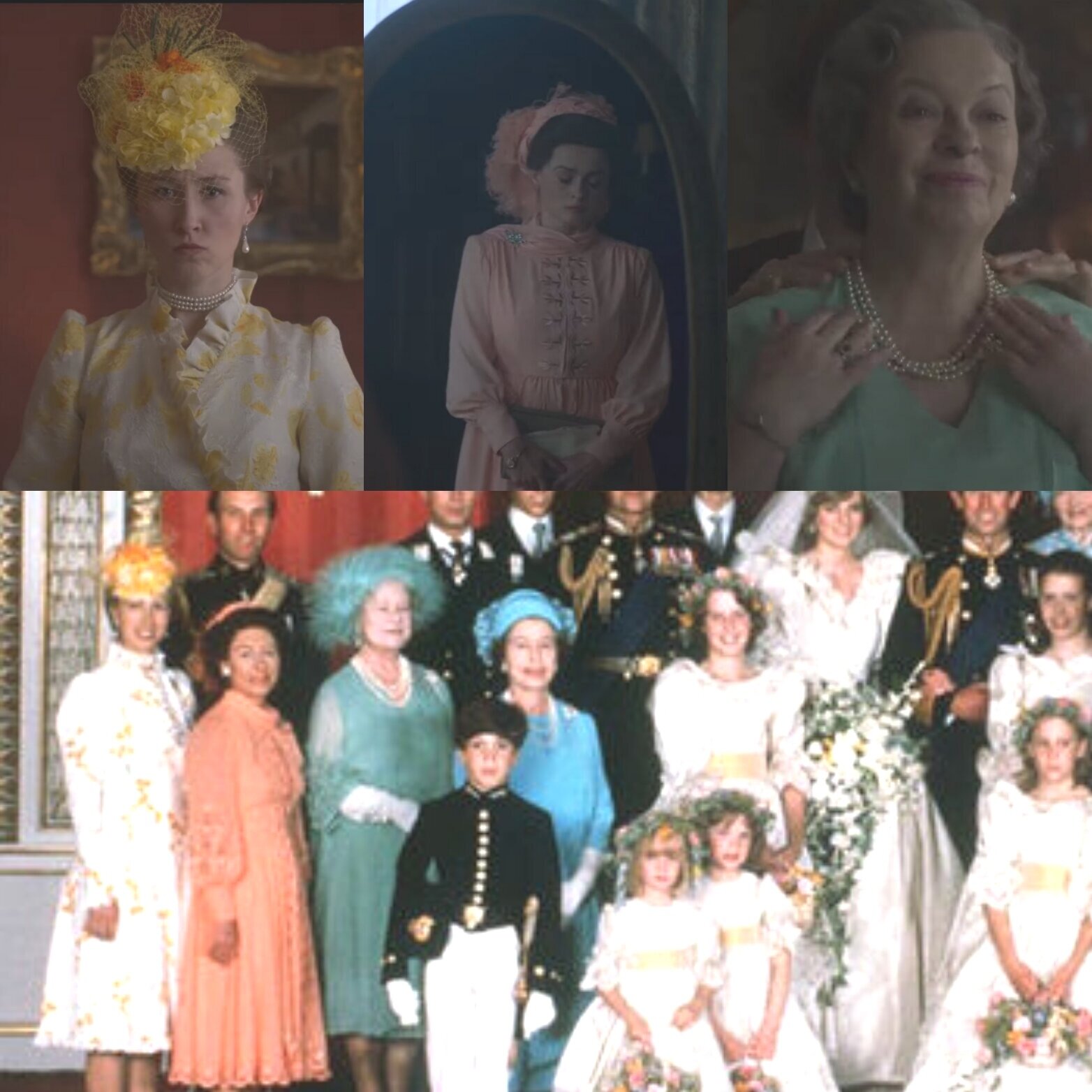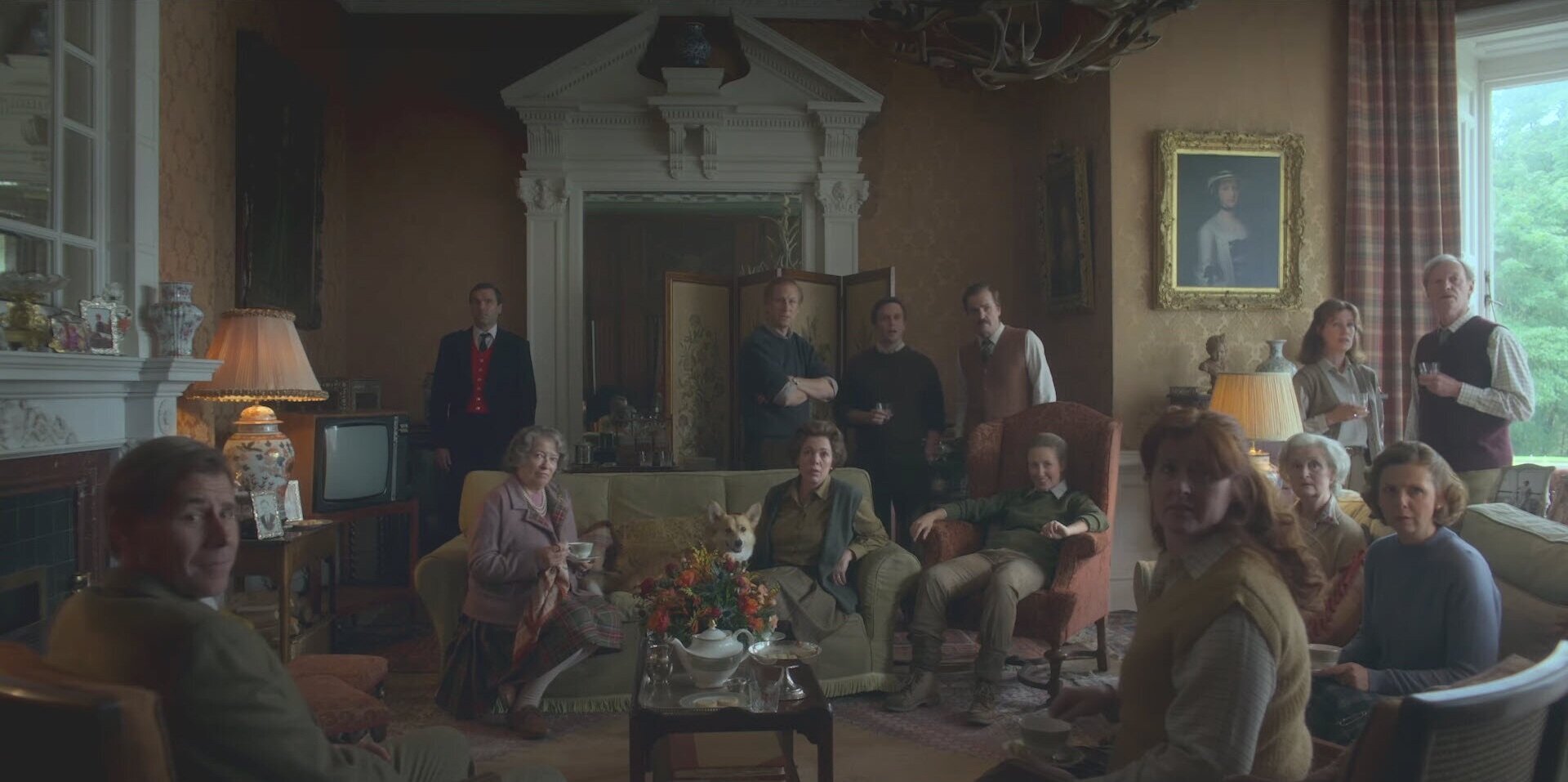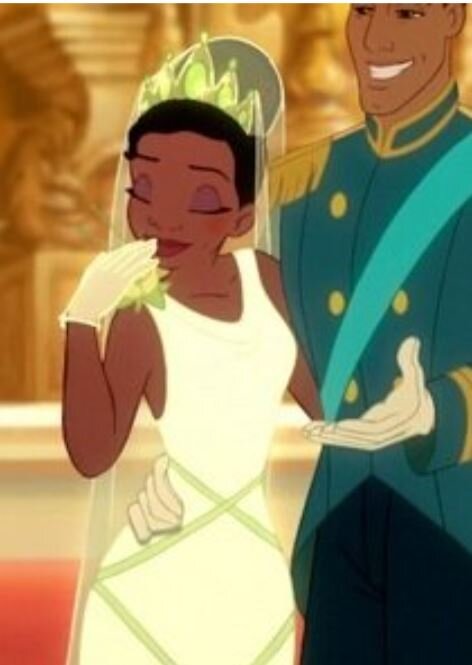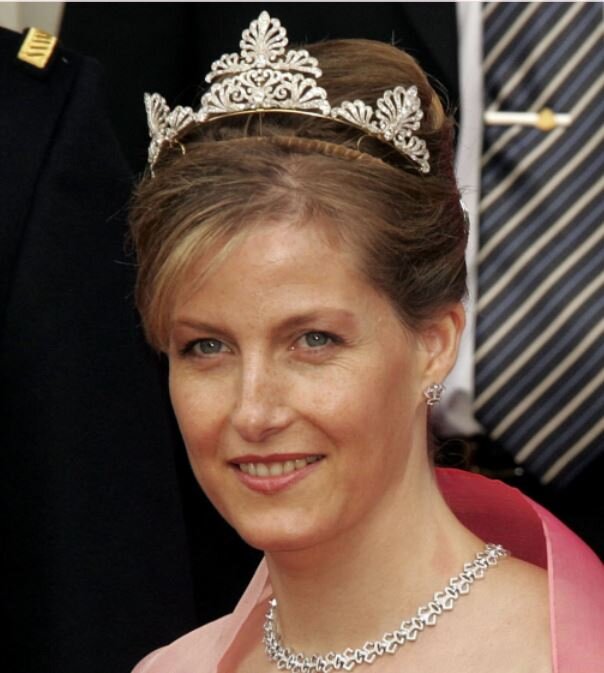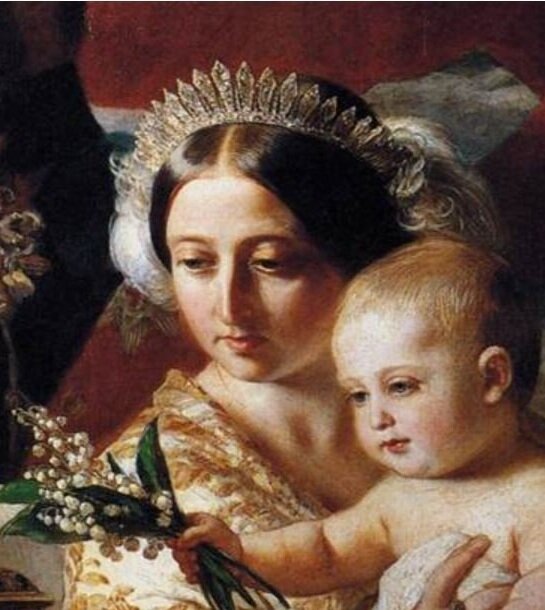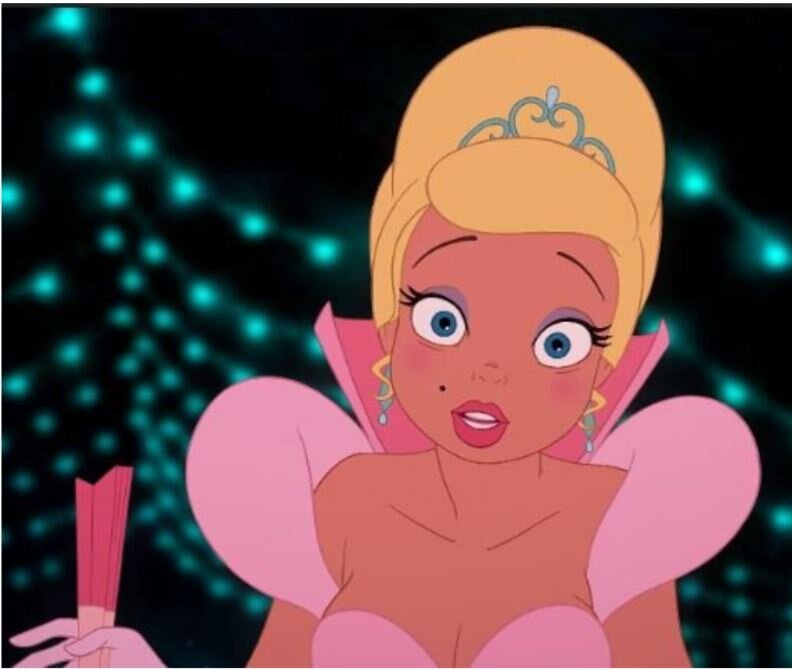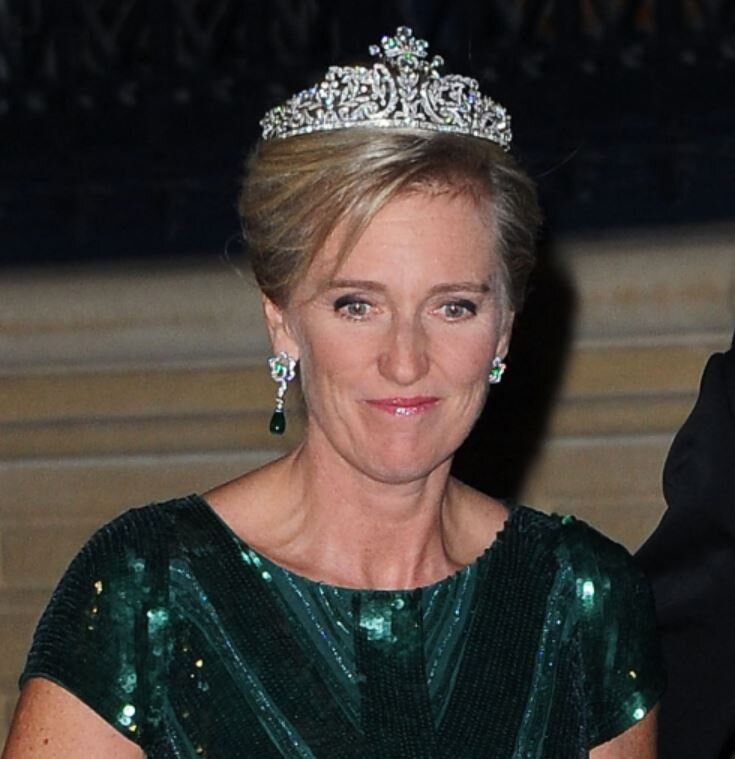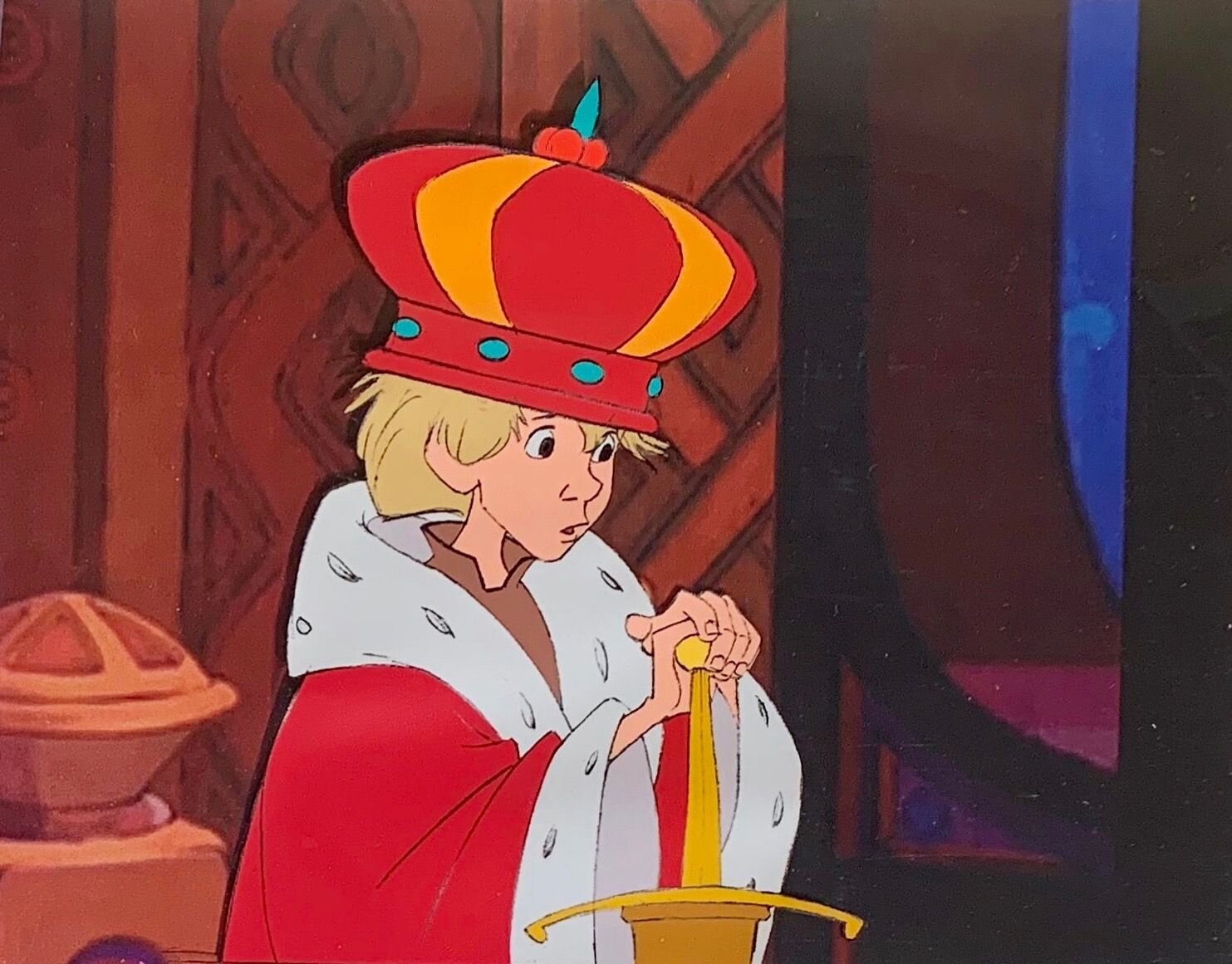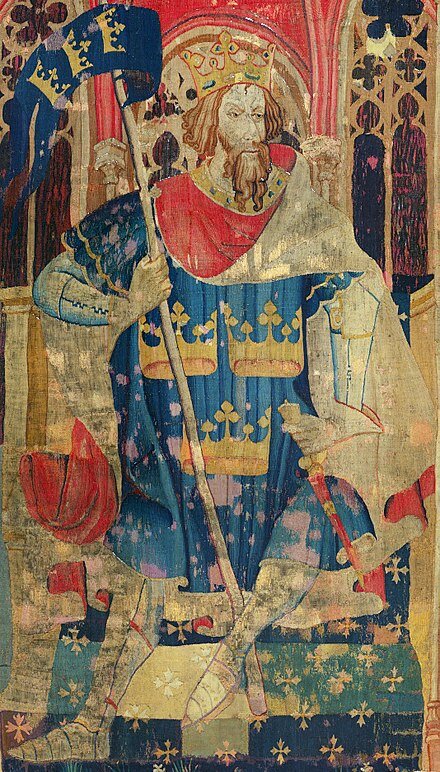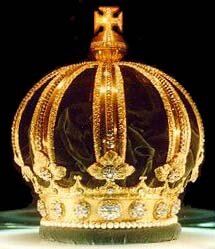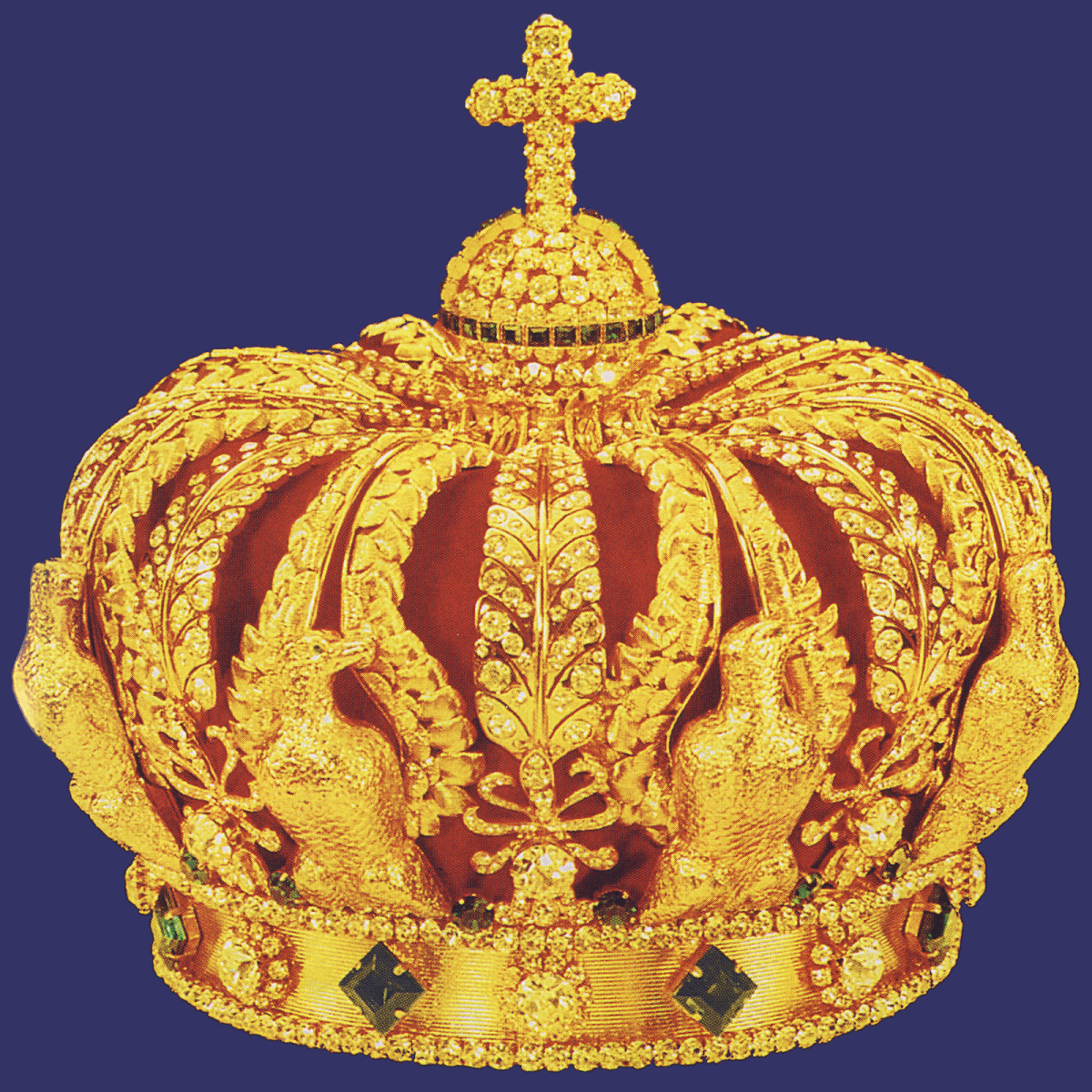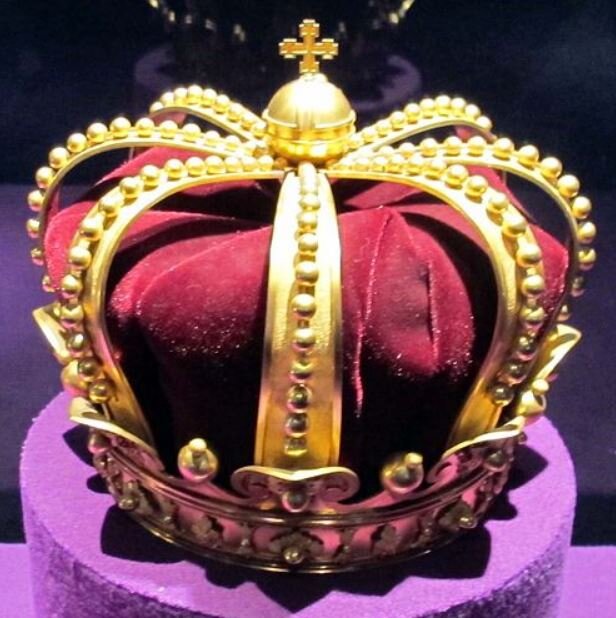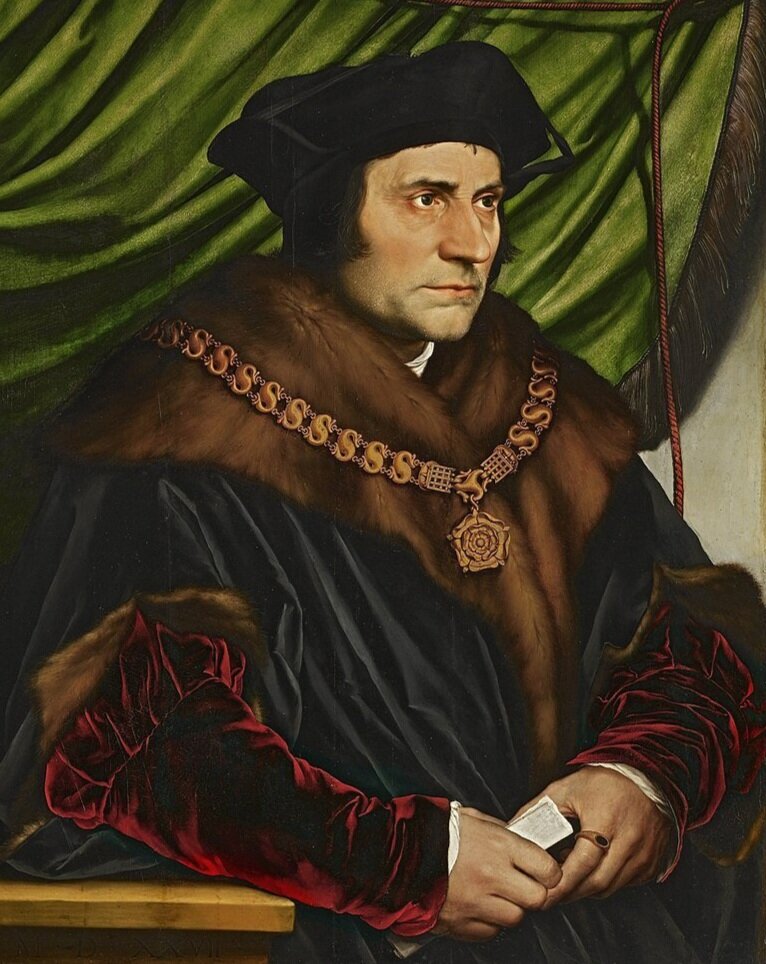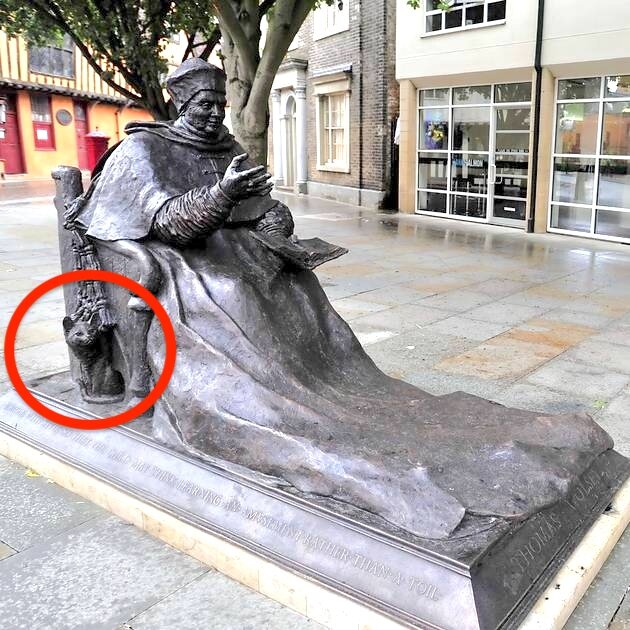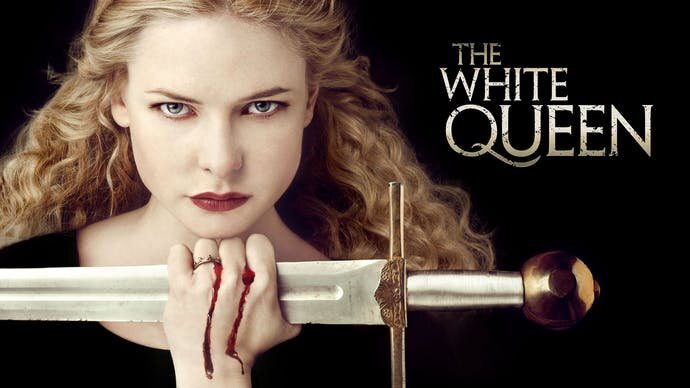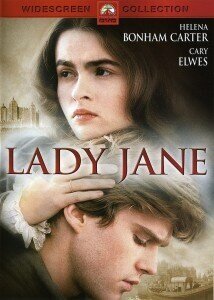Over-Analyzing The Crown: S4E4 Favourites
All My Posts on The Crown
S3: 1 & 2: “Olding” & “Margaretology” 3: “Aberfan” 4: “Bubbikins, 5: “Coup” 6: “Tywysog Cymru” 7: “Moondust" 8: “Dangling Man” 9: “Imbroglio” 10: “Cri de Coeur”
S4: 1: “Gold Stick” 2: “The Balmoral Test” 3: “Fairytale” ( + Cinderella References) 4: “Favourites” 5: “Fagan” 6: “Terra Nullius” 7: ”The Hereditary Principle” 8: “48:1” 9: “Avalanche”
The Medals, Sashes, and Tiaras of The Crown; Tiaras/Crowns Overviews: Season 1 ; Season 2
Since I had great fun over-analyzing every episode of Season 3 of The Crown last year, I’m doing the same thing this year! So if you haven’t watched Season 4 Episode 4 of the Crown yet and don’t want to be spoiled, please stop reading now. :)
The Queen and Prince Charles in the gardens at Highgrove in The Crown.
Top two: Mark Thatcher in The Crown.
Bottom Left: Mark Thatcher with co-driver Charlotte Verney (Credit: PA).
Bottom Right: Mark Thatcher in race car (Credit: Fox Photos / Getty).
The 1,000 kilometer Paris-Dakar car rally starts off the episode in Paris 1982 with zero explanation, leaving any watchers who aren’t aware of the situation to be pretty clueless until Margaret Thatcher explains what’s going on in her meeting with the queen. Although we’ve seen Mark Thatcher very briefly in shots with his family in episode 1 of this season, it was in a very different context.
The actor who plays Mark Thatcher in the series reminds me very much of Alfie Allen from Game of Thrones and every time I see him I just go, “THEON!?” But no, this actor’s name is actually Freddie Fox. Which is fantastic and I love the alliterative look alike British actors. More please.
After Thatcher’s team rolls out of Paris, we get a quick switch to Thatcher arriving at Buckingham Palace, juxtaposing the scenes of mother and son in their cars. Margaret Thatcher is in a dark blue plaid for this meeting with the queen and looks thinner and more haggard than she has in previous episodes. The queen confronts Margaret Thatcher with the state of the country, pointing out that after three years with Thatcher as PM, the country currently has inflation at 12%, unemployment at 3 million, and riots and unrests in several cities. She tries to focus on work for a bit, noting, "It’s true, but there isn’t a magical system whereby you can just push a few buttons and twiddle a few knobs and everything will be alright. Of course i would like to reduce interest rates…[the queen interrupts to ask if she’s alright] ...but to do that, we first need to get the inflation rate down, and that means we need to cut public spending." Then, on the edge of tears, she says, “I would like to be very much tougher, but I can't go faster than parliament and the people will let me."
This brief conversation about the economy before Margaret breaks down over her son’s disappearance introduces several themes (unemployment, reduction of public spending, civil unrest over the economy) that is somewhat dropped for the rest of this episode, but will become extremely important in the next episode “Fagan.”
In addition, this conversation about the economy clearly places the queen in her role as “mother of the country,” concerned over her people’s welfare and advocating for them in the face of Thatcher’s economic reform. Thatcher is set up as the antagonist willing to do whatever it takes to reach her goals. However, as is about to revealed, this view of “the queen is caring and thatcher doesn’t care” is far too simplistic.
Thatcher begins to tear up, saying with embarrassment, “the very idea that the first time a prime minister should break down in this room and it be a woman.”
I honestly would be very surprised if the Queen in real life wouldn’t have already heard about Mark’s disappearance before her audience with Margaret Thatcher. As we’ve seen numerous times over the series, the royal family actively reads multiple newspapers and regularly follows the news both on the radio and on TV. And she’s the queen. She absolutely would have been briefed on that situation the MOMENT anyone knew about it.
The Queen quite matter-of-factly says, "It is by no means the first time a prime minister has broken down in here. This is drawing room, office, confessional, and psychologist's couch," and then offers her “paper hankies” (everyone else calls them “tissues,” Elizabeth, I promise) and a drink.
It’s hard to know which prime minister the Queen might be referring to here, but within the show’s story, we know that she rebuked Winston Churchill in S1E7 Scientia Potentia Est (when he hid his two strokes from her, while the Foreign Secretary Anthony Eden was simultaneously ill and out of commission), confronted Anthony Eden over his secret dealings during the Suez Canal crisis (S2E1 Misadventure), and passive-aggressively criticized Harold MacMillan for resigning in S2E10 Mystery Man. I should note though that, rebuked/confronted/criticized are all relative terms here, and we’ve never seen the queen get truly angry or upset with one of her prime ministers up to this point in the series. And certainly we’ve never seen a prime minister deal with a personal family crisis of this level before. It honestly reminds me much more of the West Wing plotline in which the president’s daughter is kidnapped than any story line we’ve seen in The Crown before.
During this scene, Thatcher is in her standard power blue color, but in a softer looser dress than her usual business like skirt suit, perhaps pointing her dual identities as prime minister and mother. The Queen wears a dark blue and purple paisley print dress in a similar dress shape with a pussy bow neck (which we’ve seen Margaret Thatcher wear before in this season and will see her wear again). The matching blue tones indicate the common motherhood between the two very different women.
The show portrays Mark Thatcher’s disappearance as happening roughly around the same time as the start of the Falklands War. In real life, Mark’s team (which included Mark, his French co-driver Anne-Charlotte Verney, and their mechanic) went missing for January 9-14, 1982. The initial events that led to the Falklands War did not occur until mid-March 1982.
All the historical accounts of Mark make him sound like a bit of a prat, honestly. His team was 31 miles off course when they found him, and it appears the whole thing was rather embarrassing to the real life Margaret Thatcher. The Prime Minister personally paid 2,000 pounds toward the search costs and also took care of Marks’ unpaid hotel bill (one third of which was for drinks).
The Crown portrays Mark as the navigator who gets his team lost. In real life, Mark admitted in 2004 that he had not prepared himself for the trip, but also blamed their loss on other teams incorrectly saying his team were 25 miles west when they finished the section of the race, when in fact, they were 25 miles east.
Margaret Thatcher’s characterization of Mark as “a very special child, the kind of son any mother would dream of having” seems a bit hyperbolic, as in real life, he didn’t go to university due to poor academic performance, failed his accountancy exams three times, had a series of short-term jobs, set up a racing company which performed badly financially, and caused his mother numerous headaches throughout her time as PM, as he engaged in shady and controversial business dealings with the Sultan of Brunei, a university in Oman, Saudi Arabia, and South Africa. He also was convicted of funding a coup d’etat attempt in Equatorial Guinea, because OF COURSE that’s a thing that people do.
The frame story of the Queen’s plot this episode is set when Margaret Thatcher “without equivocation” names Mark as her favorite child. Elizabeth is Capital-A Appalled by this blatant admission of favoritism and tells Philip about it, who just laughs over the whole thing and says that every parent has a favorite. He then quickly, without any thought, says that Anne is his favorite.
We don’t know if Prince Philip would refer to Anne as his favorite in real life, but they do appear to be very close. Anne is their only daughter and appears to share a no-nonsense personality and a love for hunting and horseback riding with Philip. As we saw in the first episode of Season 4, Philip is depicted as being extremely proud of Anne’s equestrian achievements, including her participation in the Olympics.
Philip seems to think that the Queen’s favorite child is incredibly obvious, saying that “everyone knows” who it is, but he won’t tell her who he thinks it is. This scene is notably set next to their giant collection of framed photographs of their family, which has appeared throughout the series and somewhat shocks me every time, as they seem to have several shelves that are just full to the brim of them.
On The Crown podcast, show creator Peter Morgan says this episode was highly inspired by one royal watcher’s theory that Charles (1948) and Anne (1950), the Queen’s eldest two children, have a different relationship to their mother than the younger two children, Andrew (1959) and Edward (1963), as they were born years apart and at very different stages in her life. This theory makes a lot of sense, as the queen had both Charles and Anne before she ascended to the throne unexpectedly in 1952. That 9-15 year gap between the eldest two and the youngest two is definitely significant. It’s said she really was much more present during Andrew and Edward’s childhoods than her older two. Andrew was thought to be her favorite for quite a long time (that uh, may not be the case any more, as Andrew has been pretty much booted from the royal family due to his association with Jeffrey Epstein and you know, sex trafficking and sexual abuse). It’s said today that she tends to be closest to Edward, her youngest, and his wife Sophie (who is often chosen to ride in the car with Queen Elizabeth to church while other family members walk).
I am ashamed to admit that the ONLY reason I knew anything about the Falklands War prior to this episode was because of the 2014 Top Gear special in Patagonia, which ended uhhh rather badly when protestors in Argentina interpreted one of the license plates on the cars to be an insulting reference to the Falklands war. The show’s producers tried to explain to Argentinian officials that the license plate was real and randomly assigned, but the show’s cast and crew were ordered to leave the area immediately. There is some really terrifying footage of a mob throwing rocks and eggs at the crew’s convoy as they try to flee; the presenters had to stay behind in a hotel and were later snuck out of the country in some mysterious way. The whole situation got widespread press at the time. You can read all about it here.
From my research, it looks like the Falklands War really did begin just as uneventfully as is shown on The Crown, which Argentinian scrap metal workers arrived at Leith Harbour, South Georgia, and raised their country’s flag. This wasn’t an accident, as they were accompanied by marines posing as civilian scientists; the military junta which had been in power in Argentina since 1976 was having a lot of economic problems domestically and invaded the islands to divert attention from these issues. The junta did not believe that Britain would bother to defend the islands militarily but well, they did. And everything escalated.
In the show, the survey team walks down to the scrapworkers and the leader tells them quite clearly that they were on British overseas territory, they had landed illegally and needed to leave immediately and take their flag with them (traditionally, flags are used to claim land and establish sovereignty). The Argentine leader says in response that the British are the ones who are on the land illegally.
More signs that the initial confrontation between the Argentinian scrapworkers and the British Antarctic Survey Team was quite intentional: the raising of the Argentinian flag, the slogan “Los Malvinas son Argentinas” which one scrapworker paints on a shed made of corrugated metal (this translates to “The Falklands are Argentine.” Argentina has referred to the Falklands as Los Malvinas for years) , graffiti of a defecating pig on the survey team’s sign, the Argentines immediately bursting into “Viva Argentina!” after being confronted by the survey team, and later singing the Argentinian national anthem.
The pig graffiti is shown only very briefly, but may refer to the wild pigs which lived on the Falklands, which were routinely hunted by British and American sailors replenishing their provisions in the 1700s. (Non Sequitur: While researching this, I also came across the fantastic story of Tirpitz, a pig captured from the Imperial German Navy in 1914 after the battle of the Falkland Islands. When the Germans abandoned their ship and scuttled it, they abandoned the pig, but she managed to swim to the nearby British Royal Navy ships, where she was saved, brought aboard, and named Tirpitz after a German admiral.)
The Argentinian National Anthem they sing in the show starts off: “Oíd, mortales, el grito sagrado: ¡Libertad, libertad, libertad! Oíd el ruido de rotas cadenas, Ved en trono a la noble igualdad” which translates to “Mortals! Hear the sacred cry: Freedom, freedom, freedom! Hear the noise of broken chains, see noble Equality enthroned.” Interestingly enough, in the show, they then jump down to the NINTH verse of the song, “ya su trono dignísimo abrieron las Provincias Unidas del Sud,” which translates to “The United Provinces of the South have now displayed their most honorable throne". I guess this line just sounded more patriotic then the next line in the first verse?
I love that as the Argentine’s song fades, the next scene starts off with a look at the royal standard flying over Buckingham Palace, like a little hat nod to the whole flag/land claim controversy that just happened, but no one else knows about yet.
The whole favoritism discussion with Philip inspires the Queen to ask her private secretary to set up personal meetings with each of her children. The normally unflappable Martin Charteris looks…slightly taken aback at this request, but takes it in stride. Elizabeth also asks for a briefing document to be prepared on each child, which had me ROLLING on the floor laughing. “One would hate to be uniformed. or cold. or remotely remote.”
In this scene, Queen Elizabeth is wearing a strand of pearls. We know that Elizabeth’s first pearl necklace was given to her by her father, King George V. She wears them very often, so it doesn’t stand out as anything too unusual, but it does seem to indicate “family” here.
The episode’s frame story is a rather transparent ploy to introduce us to the queen’s younger two kids (who have only been in the background previously; I don’t think we ever have heard them speak before honestly) and check in on where all the kids are in their life, but the actual stories and scenes that come out in this episode are honestly some of the most affecting and chilling throughout the whole season, as they focus really on quiet talks between the royal family members about their roles and lives, rather than intense action.
This exact photo of Margaret Thatcher and her family appears in a quick shot in the show.
The next shot in 10 Downing Street focuses on two framed photos; one of the family together (which looks to be this real life photo of Margaret Thatcher’s family) and one just of Mark Thatcher alone, indicating his place as the favored child. Margaret, Denis, and Carol all sit close together, wearing various shades and prints of brown and tan, as some of Margaret’s advisors talk to her about possible leads for finding Mark. A Swiss driver apparently saw Mark alive on the previous day, but now they can’t locate that Swiss driver; Denis notes with frustration that “they can’t even find the drivers who aren’t lost,” and concludes that he needs to fly out to join the search. In real life, Denis did indeed fly out to Algeria to help with the search.
The advisors then bring up the Falklands situation to Margaret Thatcher and note that the governor of the Falklands has asked for an ice breaking vessel to come to the island of South Georgia to evict the Argentine scrap metal workers. Margaret, who is looking increasingly gaunt and hollow eyed, doesn’t even look as her advisors as they bring this up, and her husband ends up quietly shooing them away. They conclude that they’ll bring it the foreign secretary.
Margaret’s apparent paralysis due to the disappearance of her favorite child is in sharp contrast to the way she interacts with her daughter Carol, who looks at her with concern and unease, as if she doesn’t know how to interact with her. Margaret doesn’t even acknowledge that Carol is in the room as she knocks back another glass of whiskey.
The theme of caring vs. not caring flips here, as it becomes obvious throughout the episode that the normally tough and seemingly uncaring Margaret Thatcher is very close to her son and is an absolute wreck while he’s missing. This is pretty historically accurate, as numerous people close to the PM at the time have said that this is the only time they saw her basically unable to function as a leader, completely consumed with worry over her son (source: The Crown Podcast). In contrast, the Queen, who is traditionally seen as the softer, more caring person in the Thatcher/Queen relationship, has a far more distant relationship with her children, to the extent that her asking to see each of them privately causes them alarm.
Left, Prince Edward in The Crown.
Top Right: Prince Edward with Queen Elizabeth (Credit: PA / Getty).
Bottom Right: Prince Edward (Credit: Anwar Hussein / Getty).
The 18-year-old Prince Edward is introduced with a bit of a bang, as we hear him before we see him, bitching about traffic, clearly responding to a secretary telling him he’s late for his lunch date with the Queen. The Queen is in yet another loose long sleeved dress with a pussy bow and her pearls, but this time, it’s in a brown print, which goes with Edward’s tan tweed jacket, tying them together and also hearkening back to the Thatchers’ shared brown tones. Remember also, Edward is attending Gordonstoun in Scotland (where we saw Charles and Philip back in S2E9 Paterfamilias; Andrew also attended Gordonstoun); the tweed cloth (originally made in Scotland) ties him back to that. His youth is further indicated by his braces (which he really did have).
Edward says about the secretaries, with no trace of shame, “There’s a nasty, officious imperiousness and sense of entitlement to these people,” and then later in the scene talks about how Cambridge will be glad to have him regardless of his grades, and how the family deserves special treatment for all that they do for the country.
One of Edward’s first questions to his mother is whether he’s still getting his civil list money. The Queen raises her eyebrows at this but mildly says, “yes, all 20 thousand pounds of it.” Edward claims it mostly goes to secretarial expenses, but the queen counters that only 800 pounds of it goes to secretaries (indicating that she is far more savvy about her children’s finances than perhaps they realize). Edward waves off her concerns about the cost by saying the money is all put away in a trust, but doesn’t really answer.
Although the civil list was abolished in 2011, before then, it referred to the annual grant that covered the expenses of the Sovereign and the upkeep of the royal households (referring to the various departments serving the royal family). The civil list money did not cover transport and security for the Royal Family or property maintenance costs, which were covered by separate departments.
I’ve had a bit of trouble finding the details of civil list money for the royals in the 1980s, or any information on at what age members of the royal family would first be given a secretary, but I’ll keep looking and update this as I find out more.
Edward says he had a bet with his protection officer that the lunch would be poached salmon. Apparently the queen really does love salmon, and you can even find two of her former chef’s salmon recipes here. This offhand comment also indicates Edward’s close relationship with his protection officers; apparently he was so close to one of them that he’d call him up to tell him about good grades he got at school (Source: The Crown Podcast). Edward then talks about his experiences as guardian/head boy (a position he really had) and his experiences being bullied. We don’t know for sure if Edward was bullied, but Charles definitely had a lot of trouble at school. Edward seems clearly uncomfortable talking about it with his mother, in the show.
“Don’t Worry! I’ve met all the Cambridge admissions people, they’re going to make it happen. They’re no fools. It’s good for them too. A member of the royal family at Jesus college? just wait to see how the applications rocket.” When the Queen says this isn’t a very attractive attitude, Edward responds that it’s true, and it would be true with the marines, the City, or any other area of life he might fancy. “People will always want me. and what do you expect me to do about that? Say no? There has to be some upside to being who we are. And some return for what we do for the country.”
These few lines have so many real life Edward references in them.
Edward DID go to Jesus college at Cambridge, and his acceptance into the program was quite controversial due to his poor grades. I’ll be honest, I don’t entirely understand the British educational exam grading setup, but I do know that O-Levels are required exams usually taken at age 16 and are supposed to indicate readiness for more advanced “A-Level” classes. Edward received 9 O-levels and 3 A-levels. Apparently you also get grades for the A-Levels; generally, Cambridge would only accept students with straight As on their A-Levels, but Edward got a C and two Ds.
The Marines had paid 12,000 pounds of Edward’s Cambridge tuition in return for his serving for 5 years, but Edward dropped out of the service only a few months into his training course (his father was apparently VERY ANGRY about that).
I’m not entirely sure what “The City” means here, but i believe it usually refers to the city of london? I couldn’t find exactly what this refers to in Edward’s biography.
This is the most in depth look we get at Edward for the entire season, so I’ll quickly cover a few more highlights from his life in the 80s. After dropping out of the marines, he COMMISSIONED A MUSICAL from Andrew Lloyd Weber and Tim Rice for his mother’s 60th birthday. He then ended up getting a job at Lloyd Weber’s theatre company and worked as a production assistant for a few musicals. in 1987, he put together a television programme called “The Grand Knockout Tournament” in which four teams of celebrities and personalities sponsored by him, Princess Anne, and the Duke and Duchess of York (Andrew and Sarah Ferguson) competed for charity. They actually managed to get big names such as John Cleese, John Travolta, Meat Loaf, and Jane Seymour. The programme raised over a million pounds for its charities, but was roundly criticized by the press and thought of as pretty ridiculous and humiliating for those who participated in it. Apparently in one activity, players dressed up as giant vegetables and threw fake hams at each other? I desperately need to find and watch this.
We flip back to 10 Downing Street, where Carol Thatcher confirms that her father’s arrived safely in Algiers (and finally gets at least a thank you from her mother), and advisors update Margaret Thatcher on the state of the search. They note that they’ve narrowed the search slightly, but still have a search area of approximately 130,000 square miles, which they note, is larger than the entire United Kingdom. Although the PM acts like she really wants to just focus on her son, she is forced to pay attention to the Falklands situation, which continues to grow in scope. Another advisor reports that the HMS Endurance is on its way to South Georgia with a combat unit of Royal Marines and that the junta in Argentina has responded by sending out its own ice breaking ship and two missile-carrying corvettes (“corvettes” here refers to multi-purpose military ships, not cars); the foreign secretary has advised that the UK call off the Endurance and back off to avoid “unnecessary conflict” with Argentina while the situation is resolved diplomatically. Margaret is appalled by this suggestion, asking repeatedly, “You mean to do nothing?” and “How will it be well if we do nothing” and insisting that the Endurance must continue on, as British citizens far from home are in danger and must be protected. Her advisors and Carol (who has moved away from the table as important government business is being discussed, but is still nearby) share a worried glance, realizing that the PM is clearly projecting her concerns about her son onto this situation. The PM quickly moves back to worrying about Mark again.
The PM is in a dark blue outfit with almost a double breasted silhouette to it, with two lines of buttons down the front. This almost gives her a military look, which ties in nicely with her insistence on pursuing military action in the Falklands, despite her foreign secretary’s inclination to drop the matter. Also - it looks like every one of Margaret’s advisors is also wearing some blue in this scene. Carol, in contrast, is wearing a red and burgundy print with no blue, indicating that she’s an outsider in the government situation unfolding in front of her.
The “Do Nothing!?” conversation points to several things here: the Prime Minister’s characterization as a woman who needs to act, her worry as a mother over her son, and the repeated characterization of the Queen’s job as “to do nothing” (which has been discussed in depth several times throughout the series). It also foreshadows the Queen’s advice to Anne that will happen in the next scene.
This scene hearkens back to S1E4 of The Crown, “Act of God,” which is set before Elizabeth has even been officially crowned. In that episode, which features the famous smog that shut down London for several days, the new queen has an important discussion on her role with her grandmother, Queen Mary.
Queen Elizabeth II : It doesn't feel right, as Head of State, to do nothing.
Queen Mary : It is exactly right.
QEII : Is it? But surely doing nothing is no job at all?
QM : To do nothing is the hardest job of all. And it will take every ounce of energy that you have. To be impartial is not natural, not human. People will always want you to smile or agree or frown. And the minute you do, you will have declared a position. A point of view. And that is the one thing as sovereign that you are not entitled to do. The less you do, the less you say or agree or smile...
QEII : Or think? Or feel? Or breathe? Or exist?
QM : The better.
Top: The Queen and Princess Anne in The Crown.
Bottom Left: Princess Anne in equestrian competition (Credit: PA / Getty).
Bottom Right: Princess Anne (Credit: David Hartley).
Off we get back to the Queen visiting her children. Next up is Princess Anne. Elizabeth visits her at her home in the country, where they ride out together and talk over tea while sitting on a picnic blanket. Everything about the set up for this scene emphasizes how similar Elizabeth and her daughter are, but this illusion is quickly dispelled by their conversation, which reveals how different they really are.
The Queen coos over Anne’s horses and talks to them affectionately, as well as specifically addressing the stablehand by name. Olivia Colman has said in interviews that she doesn’t really like horses, but you would never ever guess by looking at her in these little scenes. Such a good actress.
The Queen starts out in a green skirt suit and changes into more comfortable green and tan riding gear, including a hairscarf. Anne also wears a hairscarf, but wears blue and white and a black hat over her scarf in an almost uniform look. It hearkens back to her equestrianism, which sadly, isn’t going so well at this point. It’s only slightly alluded to in this conversation, but Anne had a number of embarrassing falls from her horse in 1982 (when this episode is set) that were widely covered in the press, which helps explain her dark mood toward them right now. Their different styles and colors set them apart. In addition, the queen is sort of blending into the green background as they talk, while Anne is clearly standing out from it all, illustrating her discontent with her life.
The Queen coos about her daughter’s life being exactly what she wants, out in the country, with privacy, children, horses, and mud, but Anne instantly shoots this idyllic view down, saying acerbically that it isn’t the Eden the Queen makes it out to be. She specifically says that there isn’t privacy, noting bitterly that the press has got it in for her. The Queen rebukes her slightly for referring to the press as “bastards,” and Anne shoots back, “I told them to naff off once. and can you blame me? They’re so mean to me all the time.” This refers back to the incidents in which Anne fell off her horse and yelled at the press for photographing it. This article from Express has some of the journalists saying that Anne actually said worse things, but the press toned it down for print.
Anne states that she’s doing work in third world countries for real charities and real causes but that her work is being ignored in favor of Princess Diana, who gets attention for just wearing a new frock. In real life, Anne was president of Save the Children from 1970 to 2017 and during the 70s and 80s, travelled all over the world in support of the organization, including Kenya, Australia, and Gambia. Anne consistently tops the annual lists of “busiest royals” even today and appears at hundreds of official appearances and engagements throughout the year.
Diana herself said in interviews that early on in her position as Princess of Wales, no one expected her to do anything but show up and look pretty. Diana’s huge popularity from the start of her engagement to Charles was really unprecedented and took everyone by surprise. Although there’s no evidence supporting any serious fallouts or problems between Anne and Diana, it makes sense that Anne might have been annoyed by the disparate press attention they were getting.The Queen brings up rumors she’d heard of Anne having an affair with a bodyguard named Sergeant Cross. In real life, Sergeant Peter Cross worked as a member of the Royal Protection Squad for Anne for about a year starting in 1979. He later claimed that he’d had an affair with Anne and sold his story to the tabloids. Although this doesn’t come up again throughout season 4, Anne would later have an affair with an equerry to the Queen named Commander Timothy Laurence. A few of Laurence’s love letters to Anne were stolen in 1989 and given to The Sun, which published them. Anne would separate from her husband Mark Philips in 1989 and the two divorced in April 1992. Eight months later, she would marry Laurence. They’re still married today.
Anne has a deeply moving speech about how unhappy she is, how she used to enjoy being “the difficult one,” but now just feels reckless and angry and upset all the time. It’s hard for me to analyze this much, as we know that her marriage wasn’t terribly happy, but we don’t know much more about that. But it is really beautifully done, and demonstrates why this character is so adored by fans.
The Queen suggests that Anne wait out both her unhappiness with her marriage and her unhappiness with her life in general. Anne asks angrily, “Is that it? Is doing nothing your solution to everything?" This points back to the previous scene with Thatcher’s anger over doing nothing in the Falklands. Anne rides away from her mother, clearly still upset.
Next, we see news reports that Mark Thatcher has been found and is safely coming home. On the news, the PM says “Now of course, you are all used to thinking of me as prime minister. but what the last few days has shown me very clearly is that, above all else, I am a mother.” The Queen watches this report with a troubled expression, as if she’s not sure whether she could say the same about her role as queen vs. mother. Philip uses the opportunity to ask Elizabeth if she’s figured out who her favorite child is yet; she gives him a look of disdain in response.
Back at 10 Downing Street, the PM’s favoritism toward her son is revealed as she personally serves him a welcome home dinner. Mark continues to be a prat as he boasts about how he was never worried about his life, although his team members “were getting existential,” and wasn’t actually lost, as he always knew where he was. His father and sister look at him with a bit of shock, slightly appalled by his tone and response to the whole situation. Carol points out that he was off course and that his co-driver was taken to the hospital with heatstroke, but he claims defensively that the whole point of the race is that there isn’t a course and says his driver was being overdramatic. His mother encourages him, blaming his team’s fears about death on them being French and his co-driver’s “over-dramatic” heatstroke on her being a woman (this introduces Margaret’s thoughts toward anyone who might be considered “weak”).
The trend of spoiled sons commenting on their mother’s meal choices continues as Mark selfishly asks where the gravy is for his favorite dish, Toad in the Hole. Apparently English Toad in the Hole consists of sausages in Yorkshire pudding batter (in the US, it’s eggs baked into toast).
News announcers earlier mentioned that his father Denis embraced the helicopter pilot who spotted Mark’s team. This is in sharp contrast to Mark’s own ungratefulness toward his rescuers, which revealed in the dinner conversation as he gets home.
The costumes at the dinner table help illustrate the relationship dynamics at work. Mark is in a blue shirt with a yellow sweater tied around his shoulders. Margaret is in a matching gold and tan print. Denis is in blue and Carol is in a dark green print. Mark, Denis, and Carol are all somewhat relating to each other in the conversation and at this moment, but Margaret is clearly only focused on Mark at this point.
Carol, disgusted by the obvious favoritism toward her idiot brother, goes off to the kitchen, where her father comforts her, saying “it’s mothers and sons, that’s all.” He then refuses to answer the knock at the door, saying with a smile that it wouldn’t be for him, and that he and Carol are just support acts in the show.
Fun Fact: Olivia Colman played Carol Thatcher in 2011 film The Iron Lady. Meryl Streep won an Oscar for her role as Margaret Thatcher. I haven’t seen it so I can’t speak to whether it portrays Margaret and Carol’s relationship similarly or not.
The knock at the door brings Margaret Thatcher back to the Falklands War, as her advisor tells her that the Argentinian government seems likely to move ahead with an attack. She closes the kitchen door behind her to keep her family away from the government work at hand. After days of ignoring the conflict herself, she’s irritated to find out that the foreign secretary, the chief of the defense staff, and the defense secretary, are all out of the country at such an important time. She demands that they all come back to the country and see her the next day.
Left, Prince Andrew in The Crown.
Top Right: Prince Andrew in royal navy uniform (Credit: Bob Thomas / Getty).
Bottom Right: Prince Andrew in front of royal navy helicopter (Credit: Hulton Deutsch / Getty).
Next, Prince Andrew, who’s serving in the Royal Navy as a helicopter pilot, flies to Windsor Castle for lunch with his mother, buzzing close enough to the castle to startle the Queen at her desk, prevent her private secretary from finishing his phone conversation, surprise the Queen Mother in the garden, and wake Princess Margaret, still in bed. Andrew jocularly throws his helmet to a waiting servant and brushes away his mother’s concerns about him taking the helicopter out for just a mother-son lunch, saying “You’re the queen and I’m second in line to the throne. If we as much as break wind, it’s a matter of national importance.” Although I don’t know if he ever did land a helicopter on the palace lawn, Andrew was apparently quite found of practical jokes as a young man, so it’s in line with his usual behavior.
Note: Male-preference primogeniture still applied to the succession to the English throne in the 1980s, so Andrew and Edward both came before Anne in the succession, although she was older. In October 2011, the rules of succession were altered so that absolute primogeniture for royals born after the date of the agreement. So although Andrew and Edward both still come before Anne in the line of succession (although all of them are far down the line now, due to Charles’s children and grandchildren), Prince William’s daughter Charlotte, born after the change in rules, is higher up in the succession than her younger brother Louis.
Queen Elizabeth has her lunch with Andrew at a small, intimate table, which contrasts sharply with the large table and formal set up in which she met Edward and likely indicates the closeness of their relationship. The Queen is back in her family pearls and in a white shirt with a blue floral print, matching her son’s blue jacket, light blue shirt, and blue, red, and white tie (the tie colors may refer to his role in the military).
Andrew asks about what title he may receive in the future when he marries, which leads into a conversation about his current love interest, “the young, racy American actress” Koo Stark. Andrew says he isn’t seriously thinking about marrying her, but in real life, it seemed that their relationship was his most serious except for that with his eventual wife. Andrew then devilishly explains the plot of the “blue” film Stark appeared in to his mother, seemingly amused at her discomfort over the description of the sexual imagery and her question of whether the film was even legal. Although his description does sound a bit like pornography, it’s apparently considered more avante garde.
Andrew and the Queen briefly mention that the film was shot at Wilton House, owned by the Herberts; this is due to the fact that the director of the film was literally a Herbert.
Although all the facts in this conversation are actually true to life, I have to think that their inclusion in this story specifically point to Prince Andrew’s modern reputation as a pedophile. Although show creator Peter Morgan has talked numerous times about how he wants to portray these people as they were known in the 1980s, and not as we know they’ll end up, I have to think he’d make an exception for Andrew, as completely overlooking his current reputation and portraying him as a good guy could backfire publicly. I honestly…really don’t want to get into all the details of Andrew’s association with Jeffrey Epstein and the sex trafficking and sexual abuse allegations against him, because it’s a horrible situation that other people have researched and covered in far more depth than I possibly could, but you can read all about them over here at Town and Country. The Wikipedia article on Prince Andrew also has a very well sourced section about it all. The whole furor forced him to permanently resign from all his public roles, and honestly, he may someday get arrested for it.
The Queen ends up saying that she’d like to make Andrew “Duke of York” upon his marriage, as it’s a title traditionally given to the second eldest and has military associations. Andrew seems taken back and delighted by this idea, asking “as in the grand old duke of…,” which refers to an English children’s nursery rhyme.
Oh, the grand old Duke of York,
He had ten thousand men;
He marched them up to the top of the hill,
And he marched them down again.
When they were up, they were up,
And when they were down, they were down,
And when they were only halfway up,
They were neither up nor down.Why wasn’t Anne made Duchess of York upon her marriage? I’m not sure, but since Anne decided to raise her children without royal titles (although the Queen offered), she may have just refused. Or it may just be a patriarchal thing. I’ll research this more and update this if I learn something new.
Andrew, with a calculating look in his eye, also notes that the previous two Dukes of York both ended up becoming monarch. This refers to George V, who became Prince of Wales and then king after his older brother died, and George VI (Elizabeth’s father), who became king after his older brother abdicated. The Queen points out that in his case, not only would Charles have to die, but Andrew would also have to murder any of Charles’s children for him to ascend to the throne. Andrew then says, “The Duke of York has history in that department too. Richard III.” The queen, through a forced smile, laughs and says that Andrew is clever.
In reality, Richard III was never Duke of York, but was actually the Duke of Gloucester. His father was Duke of York and then the title next went to his elder brother’s son Richard. The young Richard, Duke of York, was one of “The Princes in the Tower” whose disappearance was pinned on Richard. As this show is incredibly well researched, I’m sure this inaccuracy was left in intentionally, to refer to both Andrew’s and the Queen’s relative lack of historical awareness.
The segment ends with Andrew asking his mother to ensure that if the conflict in the Falklands proceeds, Andrew is able to serve on the frontlines and isn’t barred from service just because of his role as prince. The Queen heartily agrees. In real life, the British cabinet, nervous about the Queen’s son possibly being killed in action, did ask that Andrew be moved to a desk job for the duration for the conflict. However, the Queen refused, and insisted that Andrew be allowed to remain with his ship, the HMS Invincible. During the war, Prince Andrew served as a helicopter co-pilot and flew on numerous missions.
Back in 10 Downing Street, Margaret Thatcher is back in her usual power colors and looks much better than she has this entire episode, now that her son is safe and sound. She holds a cabinet meeting in which several of her cabinet members advise against taking military action in the Falklands, pointing out the unpopularity of her administration, the cost of such military action, and the fact that the country is still in a recession. However, Thatcher insists on pressing forward with military action to defend the Falklands. This all appears pretty accurate to real life. She took a big gamble on the Falklands War, which ended up bolstering her image considerably.
After Margaret asks for Carol to help her prepare dinner for the chiefs of staff, Carol finally stands up to her, confronting her with her obvious favoritism toward Mark and mistreatment of her. Margaret initially denies the favoritism, and then admits to it, claiming that it’s because Carol is weak. They discuss Margaret’s relationship with her mother and father as well; I’ve had a bit of trouble finding information about her father and mother online but will look into this more (probably through an audiobook biography when I get a chance) and update this later.
Carol is writing notes at a table, surrounded by papers, when Margaret comes into the apartment. It’s never mentioned in the show, but in real life, Carol actually worked as a journalist, first in Australia and then in the UK. She wrote a book about following her mother around on the campaign trail in 1983, wrote a biography of her father in 1996, and produced a 2003 documentary about him which featured the only public interview he ever gave. She didn’t actually live at 10 Downing Street, but it’s likely that she spent a lot of time there acquiring material for her book about her mother’s campaign, which is what seems to be shown in The Crown. It does seem that she really was there a lot in the run up to the Falklands Invasion, and did indeed help her mother feed her ministers.
Unfortunately, it appears that Margaret really did play favorites with her children. Carol spoke about it publicly, saying “I always felt I came second out of two” and “He was always more glamorous. In comparison, I was one-dimensional and dull.”
The last of the Queen’s private lunches with her children is with Charles at his new home in Highgrove. Charles himself is seen advising on the menu and fussing with the silverware on the table, further emphasizing how particular he is about things (something Camilla commented on in the previous episode). He shouts at Diana through a closed door about how she should come out and have lunch with the Queen, but the heavily pregnant Diana ignores him and watches TV instead (Bagpuss again).
Content Warning: Eating disorders, attempted suicide. [italicized]
In real life, Diana had terrible “morning sickness” (hyperemesis gravidarum) and episodes of bulimia throughout her pregnancy with William. She also was dealing with horrible pressure from the press and depression. The depiction of her in The Crown is actually a bit tame here, as in real life, she actually threw herself down the stairs during her pregnancy.
Content Warning end.
In The Crown, Elizabeth says that she was lucky and that pregnancy didn’t seem to affect her. In real life, Elizabeth had some struggles with morning sickness, but nothing even close to the extent of Diana’s hyperemesis.I talked a little bit in the previous episode’s post about how happy Charles-and-Diana seem to be represented by the color blue, while unhappy Diana is shown in yellow. In the scene where Charles is whisper-shouting at Diana through the door, he’s wearing a blue sweater and is surrounded by yellow walls (Remember: it’s Diana who decorated Highgrove). Diana herself is in a white nightgown with a blue floral robe, but clearly ignoring Charles so - she’s still trying at their relationship, but severely disillusioned.
The Queen is again in her “family” pearls and green. She’s somewhat connected to her eldest son (who changes into a grey double breasted suit with blue shirt and tie), but there’s a big distance still between them. Charles is STILL known for wearing double breasted suits, by the way.Charles shows his mother around the gardens at Highgrove rather pompously, expounding about his many gardens (which Camilla and Diana spoke about in the previous episode) and his plans for the whole place. He states that he wants the house, the land, and the gardens to express who he really is, and what he really is all about (notably never mentioning his wife or his soon to be born child). The Queen gently pokes fun at him, pointing out that his plans seemed perhaps a bit self-involved (“so the big idea is you”). Later, after he expounds on wanting an organic, natural garden, without any straight manicured lines, she playfully notes that the pool has straight lines and that the tennis court didn’t seem particularly organic.
Charles even says that he wants Highgrove to be his own Shangri La or Xanadu. Shangri-La is a fictional location described in James Hilton’s 1933 novel “Lost Horizon,” and is commonly used to describe an earthly paradise now. Xanadu was a secondary name for Shangdu, the summer capital of the Yuan dynasty of China, which was described in ecstatic terminology in a 1368 poem by Toghon Temur Khan and the 1797 poem “Kubla Kahn” by Samuel Taylor Coleridge (which is what Charles begins to recite). These literary references to various paradises pairs nicely with Anne’s earlier description of her own life as “not the Eden you think it is.”
Charles then starts to recite poetry, which seems to dismay his mother; she finds an excuse to talk about his wisteria soon afterward and stop him. This is the second time this has happened this season (Margaret Thatcher also recited poetry by Charles McKay to the Queen in S4E2) and also reflects back to Lord Mountbatten’s recitation of Rudyard Kipling’s “Mandalay” in S3e5.
A pregnant and miserable Diana in The Crown.
Over lunch, Charles talks about how unhappy Diana is, and how he doesn’t know how to cheer her up, specifically noting that she grew up in the country, so he thought she’d be happy there. In real life, Diana talked a lot about how much she loved living in the city and disliked HighGrove. This does contrast with what she said in S4E2 “The Balmoral Test” to Prince Philip. But then, she realized at the time that she was being tested, and may have exaggerated or lied about some of her true feelings as to the country.
Charles also complains about Diana being intellectually incurious, and not caring about his tutorials in Shakespeare and poetry. This further illustrates their very very different personalities and interests. He also specifically refers to writer Laurens van der Post visiting. In real life, Charles brought several books by Van der Post along on their honeymoon, hoping that they could both read and discuss the books together. This was not exactly Diana’s idea of fun.
The Queen rebukes Charles for his self-absorption, his close friendship with Camilla, and the way he’s treating Diana. When he says he talks to Camilla more when he needs cheering up, the Queen distinctly raises her voice at him, sharply saying “When you need cheering up? You’ve just bought your dream house, your Xanadu, that you and an army of sycophants are turning into the living embodiment of your soul. And your young, beautiful wife, struggling with pregnancy, has locked herself in a room upstairs and is refusing to come out. You know how I hate interfering. It’s not for me to tell a grown man what to do. But in your position I might be inclined to worry less about my own happiness and pay a little more attention to the well-being of the mother of my future child.”
Charles /almost/ seems to listen to his mother’s advice there, and looks up the staircase toward Diana’s bedroom while thinking, fiddling with his signet ring (remember, he gave Diana a signet ring of her own right before they married). However, he ends up turning away and going off on his own.
The episode’s main story with the Queen concludes with a few quick scenes. The Queen looking through family photos of her children at younger ages, gazing particularly at pictures of her father holding baby Charles in his arms, Philip (Matt Smith) playing tag with young Charles and Anne, Edward and Andrew as children, and a solemn young Charles dressed in the Eton uniform he tried on before his father decreed he was going to Gordonstoun instead. We then see her meeting with her mother and sister for an emergency talk, although we don’t see the actual conversation (note, all three women wear shades of brown and pearl necklaces in this scene, tying them all together). Finally, it all wraps up with a conversation with Prince Philip. Despite her attempts at subterfuge, Philip has known the whole time that she was meeting with all their children one on one, as they each called him to ask what was going on after receiving her invitations.
The Queen concludes that instead of Mark Thatcher, "it's our children that are lost, each in their own deserts." Philip dismisses this at first, saying roughly that Anne isn’t lost. The Queen mildly says that Anne’s marriage is lost, pointedly not revealing the other issues in Anne’s life that have been making her deeply unhappy. He then claims that Edward isn’t lost, but the Queen disagrees, describing him as “entirely lost, and bullied, and vengeful.” Philip agrees that Charles is lost, but says he always has been. She concludes with Andrew (who Philip quietly points out is her favorite), noting “I was shocked,” and then saying with foreboding, “If he doesn’t change…”, leaving the idea hanging in the air.
Sources do seem to think that Andrew is the Queen’s favorite child in real life.
The actual scene with Andrew is so subtle that I initially was left wondering why the Queen was left so worried about Andrew. I think she’s referring to his delight in freaking her out with the details of his girlfriend’s sexy film, his casual disregard to whether the film itself was legal or not, and his plain avarice and desire to be king, as evinced by his jokes about going Richard III on Charles. It’s all very under the radar and foreshadowy and I don’t think the story line would end with her so concerned about Andrew in 1982 if real life 2020 Andrew weren’t a screwup and possible criminal.
She asks Philip what their children’s unhappiness says about them as parents, noting that her mother had excused it by saying she shouldn’t blame herself, as she’s already mother to the nation. Philip agrees, and after hearing out her story about her regrets as a mother, firmly says that she is a perfectly good mother and their children, as adults, must now sort themselves out.
In this scene, the Queen is already ready for bed, wearing a nightgown and wearing no makeup, all pretense and pomp swept away as she talks about her regrets as a mother, saying she didn’t know how to be maternal toward Charles when he was a child and so let his nanny bathe him, while she watched. This story is based off of some of Charles’s own stories of his childhood. The underlying theme continues the show’s portrayal of the Queen as not really knowing how to handle emotion, previously discussed in detail in S3E3 Aberfan. Have to say, I really disagree with this line of thought. The queen may have been a bit more distant from her children then she would have liked as a mother, due to her responsibilities as monarch and the traditional child-rearing practices of both the royal family and British upper class society, but there’s never been any sign that she doesn’t know how to express emotion. There are pictures of her looking absolutely distraught at Aberfan, and she’s cried in public on numerous occasions.
The whole story overall does really underline the difficulties each royal child was facing in the early 80s, and highlights what Queen Elizabeth really gave up in order to be a good sovereign.
The episode ends with the British royal navy ships sailing off to the Falklands, carrying not only Queen Elizabeth’s son Andrew, but the children of thousands of other British citizens.








